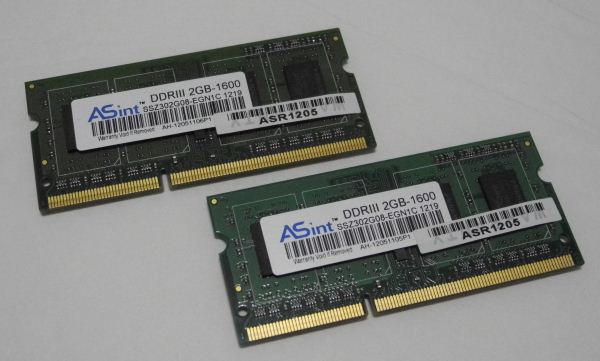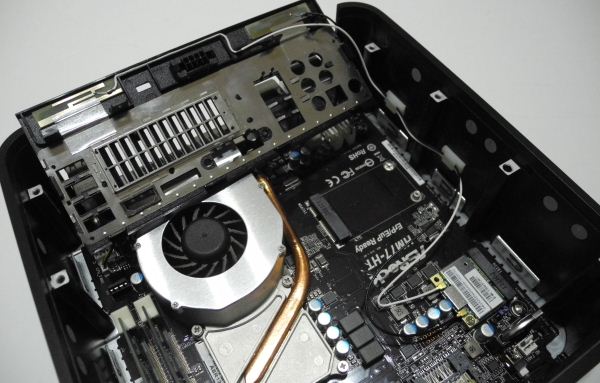ASRock Vision HT: Ivy Bridge Carries the SFF HTPC Forward
by Ganesh T S on November 12, 2012 3:30 PM EST- Posted in
- Home Theater
- ASRock
- HTPC
- Ivy Bridge
System Teardown and Analysis
The ASRock Vision HT 321B is primarily built out of notebook components, and it is quite difficult for the average enthusiast to build such a system with off-the-shelf components.
Motherboard & Chipset : mini-ITX Intel HM77
The motherboard used in the CoreHT series is based on the Panther Point Intel HM77 chipset. There are three SATA headers on the motherboard, with one connected to the hard drive, one to the optical drive and another left unconnected for a second 2.5” drive. The unit also has a mSATA slot. In addition, we also have an eSATA2 port on the rear side of the chassis.
The motherboard exposes four PCIe 2.0 x1 lanes, of which one is connected to the Atheros 9462 WLAN / Bluetooth solution, and the other is connected to the Realtek 8168 GbE controller. As seen in previous ASRock HTPCs, the two sides of the chassis are used as antennae. The two DIMM slots are on the right side of the board, next to the CPU.
CPU : Intel Core i5-3210M
The Core i5-3210M is a 35W TDP processor belonging to the 22nm Intel Ivy Bridge family. Clocking in at 2.50 GHz, it is capable of going up to 3.1 GHz in Turbo mode. The instruction and data caches are 32K each, with a 256 KB common L2 cache. For L3, we have 3MB of Intel Smart Cache shared between the two cores and the integrated GPU.
GPU : Intel HD Graphics 4000
The integrated GPU in the Ivy Bridge processors come in two varieties, namely, HD Graphics 2500 and HD Graphics 4000. The Core i5-3210M uses the latter. It has a base frequency of 650 MHz, and is capable of going up to 1.1 GHz in stressful conditions. It supports full 3D video capabilities, QuickSync v2.0 and WiDi. However, WiDi is not supported by the Vision HT 321B. WiDi makes sense for laptops, but not much for SFF HTPCs. So, we don't fault ASRock for avoiding this feature.
DRAM : ASInt 2 x 2GB DDR3-1600
Compared to the 2x2GB ASInt DDR3-1333 DIMMs used in the CoreHT 252B, ASRock has gone in for an upgrade with a 2x2GB ASInt DDR3-1600 kit for the Vision HT. The memory modules operate at 1.5V with a CAS latency of 11-11-11-28.
Hard Disk : Seagate Momentus Spinpoint 750GB 5400 rpm 2.5"
While the CoreHT 252B used a 7200rpm 500 GB drive, ASRock has opted to increase the storage capacity while bringing down the rotational speed for the Vision HT 321B. The hard drive in the unit is the Seagate Momentus ST750LM022. This drive actually belongs to the Samsung Spinpoint lineup, but Samsung’s hard disk business unit was acquired by Seagate in 2011.
The ST750LM022 isn’t going to win any hard drive benchmarks, but that is acceptable for most HTPC scenarios. Users can always install an additional SSD or mSATA drive as a primary drive for speedy storage.
Optical Disk Drive : Philips Lite-on Blu-ray / DVD RW Slot Loading Drive
The ASRock Vision HT 321B ships with the Philips Lite-on DS-4E1S BD Combo Drive. Unlike last year’s mid-range model, this one sports a slot-loading drive similar to the Vision 3D series. In fact, the drive model is the same as the one shipped with the Vision 3D 137B.
WLAN : Qualcomm Atheros AR5BWB222
ASRock has gone in for a 2T2R dual-band Wi-Fi solution with an integrated Bluetooth 4.0 radio for the Vision HT 321B. In the previous Core series solutions, the sides of the chassis were used as the antennae, but, for the Vision HT 321B, we see that the leads are soldered to the rear end.
As we will see further down in the review, users are in for a much improved wireless performance when the system is used with a capable router.
MCE Remote
ASRock doesn’t include a wireless keyboard / mouse combo with the system. However, we do have an IR receiver in the system, which is taken advantage of by the bundled MCE remote. Unfortunately, the quality of the MCE remote is a big letdown. The keys are quite small and the unit feels cheap in the hand despite being pretty decent in appearance. ASRock has been hesitant to include a better remote despite our repeated requests. Given that the Vision HT series is Bluetooth-enabled, this would have been ideal for ASRock to experiment with a new type of remote.
In the next few sections, we will take a look at the performance of the ASRock Vision HT 321B.














40 Comments
View All Comments
shurik_1 - Monday, November 12, 2012 - link
Could you test the silent data corruption issue I have described in Vision 3D comments? With Vision 3D it is still an issue when 16GB RAM are installed (with 8GB RAM they fixed it via BIOS update that they did not make publicly available) and ASRock although acknowledges its existence refuses to fix it.ganeshts - Monday, November 12, 2012 - link
I will follow up on this with ASRock. That said, I have been using the Vision HT / Vision 3D 252B to unpack a number of split archives (around 400 MB each unpacking to ~4.37 GB / ~10 GB) and not found any issues so far.But, definitely an interesting case (if there is some data corruption with a different DRAM, that may point to some issue in the DRAM module itself). Are you aware of any other users with the same issue? I am trying to see if there is something common between all the systems exhibiting this problem...
shurik_1 - Monday, November 12, 2012 - link
It will not complain at unpack because my thinking is that corruption occur at writing (at some point in my lengthy mail exchange with ASRock support Intel ME was mentioned as the culprit). I discovered the issue because par repair invariably fails on large file sets. That is why I call it silent. Did you try to create checksum of archive content and test after unpack? I have only one set of laptop 16GB modules. But when my 2nd gen Vision 3D had BIOS prior to 1.10c ("c" suffix is important here) it was present with 16GB and two different sets of 8GB modules.klmccaughey - Monday, November 12, 2012 - link
I don't understand why manufacturers can't release a cheap HTPC. It is still much more cost effective to build your own.Every time I see one of these reviews I get excited, and every time I get disappointed as I see the outrageous price tag.
EnzoFX - Monday, November 12, 2012 - link
I too wish there were cheaper alternatives. I myself have no need for optical (Ew), and am usually eyeing those tiny foxconn's that use E-350's. Though I'd more likely go with something with more performance.Perhaps this segment is too much of a niche (Probably). Intel's NUC looks promising, hope it becomes standardized so that the race to the bottom can start on those chips =P.
lurker22 - Monday, November 12, 2012 - link
Avoid the 350. Yes it will work, but a lot of use end up being slow on it especially when the GPU acceleration isn't available.StealthX32 - Monday, November 12, 2012 - link
From what I've read on a few Newegg reviews, you can get a Broadcom BCM9700xx hardware decoder card to put into the miniPCI-e slot and achieve <20% CPU utilization on even high bitrate 1080p material.I bought this from them when they had the buy an HTPC get a free SSD combo, but haven't gotten around to buying the Broadcom card yet.
lurker22 - Monday, November 12, 2012 - link
As I said, it's doing everything outside of the GPU accelerated videos that ends up being very slow. Web browsing, Netflix, etc is all CPU limited.BuddyRich - Monday, November 12, 2012 - link
Netflix via website and silverlight is bad.Youtube HD is GPU accelerated and Netflix Win8 also works nicely.
One of the few pluses of Win8!
Pipperox - Tuesday, November 13, 2012 - link
I have an E-350 based Zotac Nano.It's absolutely silent, can play most media content without a hitch (haven't tried 1080p60 content though, but 24 and 30Hz are not a problem) and with Windows 8 internet browsing and general PC usage is butter smooth.
Sure, i wouldn't do media transcoding or rendering or content creation on such a PC, but for the value and intended use I couldn't be happier.